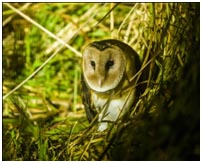
Reclusive and rarely seen owl of cane fields, meadows, and other areas with tall grassy cover. Tan-brown overall with black, white, and orange mottling on the wings. Flies low over grassy areas, primarily during dawn and dusk, often with long legs dangling. Heart-shaped facial disk, very similar to Barn Owl and Masked Owls. Nests in dense fields; fluffy owlets often exposed during harvesting season in agricultural areas.
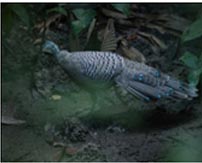
It is a large pheasant, up to 76 cm long and greyish brown with finely spotted green eyespots, an elongated bushy crest, bare pink or yellow facial skin, white throat, and grey iris, bill and legs. The sexes are rather similar, but the female is smaller, darker and less ornamented than the male. The young resemble the female
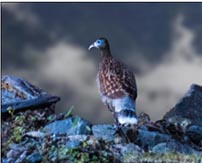
Large terrestrial bird of foothill and montane pine forests with extensive rhododendron ground cover. Male brilliantly colored but oddly vulturine in appearance, with a small peaked head and blue skin around the eye. Appears dark from a distance, with bronzed neck and orange-tipped white tail; closer looks reveal greenish-blue gloss on the wings. Female streaky brown with dark blue eye patch and white-tipped tail. Gives loud, bisyllabic raptor-like screams and babbling shrieks in alarm.
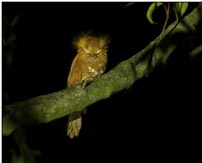
Cryptic, uncommon nightbird of evergreen and mixed foothill and montane forests (900-2000 meters). Both sexes have dappled lichen-like plumage, the male grayish, female rusty brown. Silent birds are best distinguished from other small frogmouths by range, habitat, elevation, and bird’s comparatively small size. Song a long, haunting whistle, given repeatedly in series.
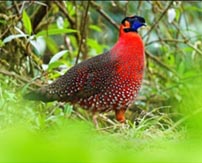
Rotund terrestrial bird of hilly forests, usually seen singly. Male exquisitely colored: bright flame-orange overall, with white dots all over the body, black face, and electric blue facial wattle that is inflated into a liver-shaped, dazzling red-and-blue flap during courtship. Female similarly shaped and sized, dark brown overall, with pale spotting and streaking. Generally quiet; courting males give loud booming moans
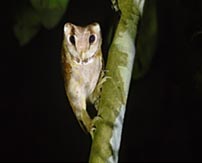
Small owl with a distinctive, highly angular head. Dark chestnut above and pale creamy gray below with light spotting on the sides. Dark eyes are emphasized by the general paleness of the face and the vertical dark ridges above them which form into small rounded tufts. Typically stands quite upright, giving it a heavy-headed appearance. Small and often difficult to find but can be common in a wide range of habitats, including evergreen forests and mangroves. Vocalizations are variable, and include rasps, screams, inflected gulping hoots, and a high-pitched mellow whistled song with the first few notes downslurred and the last few notes upslurred, which can be likened to “hii-huu-huu-huwee-huwee-huwee”.
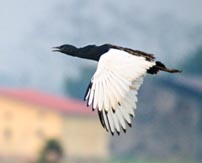
Rapidly declining dainty bustard of tall grassland. Male is black with a speckled brown back and white wings, while female is intricately patterned in buffy brown all over. Retiring and seldom seen outside of the breeding season, when the male’s extravagant leaping display flight frequently brings it above the grasses and into view.
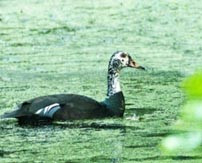
Odd shy duck with a distinctly ‘farmyard’ appearance. Distinctive white head can be quite clean-looking or densely speckled with black, depending on age and sex. When at rest or foraging, predominantly dark with white patches in the wings and on the head. Extensive white wing patches most noticeable when the bird is in flight. Inhabits quiet, secluded forest waterways. Retreats into undisturbed recesses of these waterways outside of dawn and dusk.
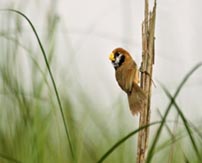
The Black-breasted Parrotbill (Paradoxornis flavirostris) is one of India’s rarest, enigmatic and least-known birds. A large, odd-looking parrotbill with a big yellow bill. Note the white face bordered by a black ear-patch and breast. Inhabits wetlands with tall reeds and grasses. Calls include a loud, nasal “cr-crwee-crwee-crwee-...” and some other repeated non-nasal notes such as “whit-whit-whit-...”. Forages among reeds in pairs or small groups.
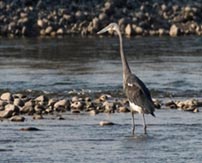
Large, imperious stone-gray heron, very locally distributed and extremely rare. Note dark gray wings, pale throat patch, and white belly. Shows strong black-and-white contrast on the underwing when in flight. Inhabits waterside areas surrounded by mature broadleaf forests in foothill and mountainous areas; particularly favors pristine mountain rivers and streams. Declining due to habitat degradation
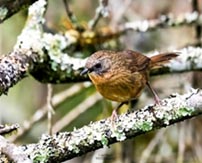
A small, rust-coloured bird with gray cheeks and white on the throat and belly. The upperparts are brown, and the rusty underparts lack the white streaks of other similar species. Skulks in undergrowth and low vegetation in evergreen forests, forest edges, and bamboo thickets. The song consists of about 3-5 strong, warbling notes.
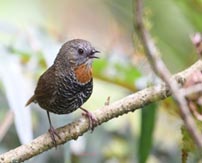
A very small, dark grayish-brown bird with a short tail, a reddish-brown throat, and a black-and-white scalloped pattern on the belly. Inconspicuously feeds in low, thick vegetation, where it is very hard to see. Similar to Rufous-throated Wren-Babbler, but Mishmi Wren-Babbler is darker overall, with a distinctive white chin and a white edge to the throat. The song is a strong, melodic burst of notes repeated 2-4 times and often followed by a short trill.
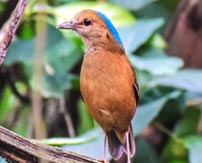
A rotund, earthen-toned ground-dweller, usually hidden deep in the undergrowth of dense forests, often in damp areas near rivers and streams. Very shy, rarely venturing out into the open, though can sometimes be seen on the sides of trails in the early morning. Male has a bright sky-blue crown and nape, tea-green wings, and an ochre-brown belly. Females have a brownish head and are a browner-toned shade of green on the wings. Song is far-carrying and simple: a loud, piercing “pee-ya!”
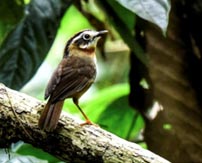
Smartly patterned small brown forest-dweller. Warm russet-brown above with smudgy gray-brown underparts. Clean white eyebrow and throat contrast sharply with an orange-brown “chinstrap” and a warm brown crown bounded by black stripes. Active in dense undergrowth, frequently traveling with other species in mixed flocks. Generally not as bold as other small fulvettas, and does not clamber around in the open on exposed trunks and branches. Song is a melodiously bright and brief “chewee-chewee-peeta!” Calls include an explosive “chom-wit!” and softer whistling and churring.
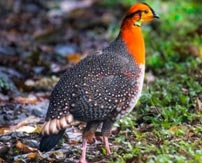
A large pheasant-like bird with a short tail. Male has a yellow face, gray upperparts with white spots, a bright red breast and back of the head, and a white band on the base of the tail. Female is brown throughout, with uniform pale speckling and an indistinct pale eye-ring. Occurs in dense evergreen montane forests, where it feeds in the undergrowth. The song is a loud, wailing “oooaaahh.
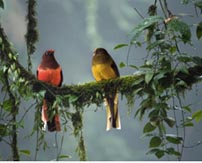
A sluggish bird of mature tropical hill forests. A small head and prominent pale eye-ring give it a comically surprised appearance. Male has a wine-purple back, a scarlet belly, and a red plush patch on the forehead. Female is brownish with a yellow cap and underparts. Like other trogons, usually still and hard to detect on a low or mid-level perch, from which it sallies out to take insects, fruits, and seeds. Song is a series of bubbling hoots that accelerate and rise, then taper off gradually towards the end.
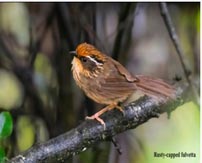
This small brown fulvetta would be drab were it not for its sharp white brow and orange forehead. Inhabits hilly and montane forests and adjacent secondary growth and gardens. Moves in small to medium-sized flocks, less frequently with other species than other fulvettas. Calls are comprised primarily of rattles and trills. Song is short and simple, a phrase of three to four sweet-sounding notes, with the last note tending to be the sharpest and loudest.
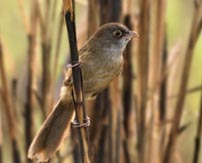
Warm brown babbler with a distinctive round-headed and short-billed profile. Extremely localized, restricted to disappearing patches of tall riverine grassland and reedbeds. Usually in pairs or small groups. Shy and skulking, typically best detected by its fluty, melodic song, but if seen well, note its gray face, pale throat, and golden “spectacles.”
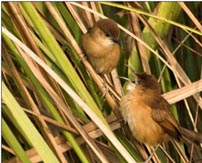
Distinctive chestnut-brown babbler with a slightly decurved bill and a pale throat. Shy and difficult to see in its well-vegetated habitat; favors wet grassy or reedy areas. Gathers in flocks outside of the breeding season. Song is a highly variable jumble of musical whistles and sometimes burry notes.
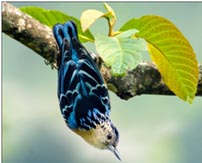
An unmistakable and fairly uncommon large nuthatch: combination of orange belly, white face, and dazzling blue banding on the wings is unique in its family. Forages in primary forests, probing beneath bark, leaves, and treetop vegetation. Joins mixed-species flocks.
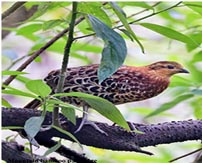
An intricately patterned partridge of various scrubby habitats; not restricted to bamboo thickets. Body is brown with black spots and gray streaks all over. Face is paler with a thick black line through the eye. Usually seen singly or in pairs. Often forages under cover but will venture out into the open; less tied to extensively thick cover than many small partridges. Song is a loud clattering series of high squealing notes, often initiated by a hoarse, throaty shriek
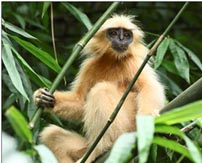
Gee's golden langur (Trachypithecus geei ), also known as simply the golden langur, is an Old World monkey found in a small region of Western Assam, India and in the neighboring foothills of the Black Mountains of Bhutan. Long considered sacred by many Himalayan people, the golden langur was first brought to the attention of the western world by the naturalist Edward Pritchard Gee in the 1950s. Adult males have a cream to golden coat with darker flanks while the females and juveniles are lighter. It has a black face and a long tail up to 50 cm (19.69 in) in length. It lives in high trees and has a herbivorous diet of ripe and unripe fruits, mature and young leaves, seeds, buds and flowers. The average group size is eight individuals, with a ratio of several females to each adult male. It is one of the most endangered primate species of India and Bhutan.

The Ganges river dolphin is known as the “Tiger of the Ganges” for the role it plays as a top predator, and because it is an ecosystem indicator species – much like a tiger is in a forest. It is legally protected in all countries within which it is found and is the National Aquatic Animal of India. Both Indus and Ganges river dolphins are considered to be living fossils, as they are the most ancient dolphin species still alive.
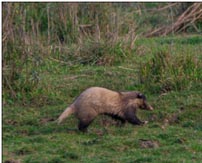
The greater hog badger is a very large terrestrial mustelid native to Southeast Asia. It is listed as Vulnerable in the IUCN Red List of Threatened Species because the global population is thought to be declining due to high levels of poaching.
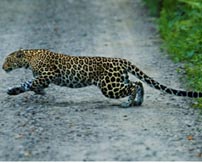
The Indian leopard (Panthera pardus fusca) is a leopard subspecies widely distributed on the Indian subcontinent. The Indian leopard is one of the big cats occurring on the Indian subcontinent, along with the Asiatic lion, Bengal tiger, Snow leopard and Clouded leopard.
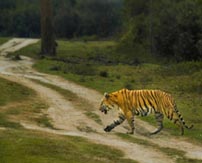
The Bengal tiger is a population of the Panthera tigris tigris subspecies and the nominate tiger subspecies. It ranks among the biggest wild cats alive today. It is considered to belong to the world's charismatic megafauna.
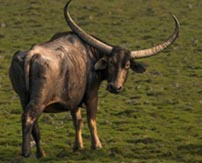
The wild water buffalo, also called Asian buffalo, Asiatic buffalo and wild buffalo, is a large bovine native to the Indian subcontinent and Southeast Asia. It has been listed as Endangered in the IUCN Red List since 1986, as the remaining population totals less than 4,000.
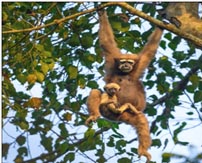
The hoolock gibbons are three primate species of genus Hoolock in the gibbon family, Hylobatidae, native to eastern Bangladesh, Northeast India, Myanmar, and Southwest China. In northeast India, the hoolock is found south of Brahmaputra and the North Bank areas and east of the Dibang Rivers.[4] Its range extends into seven states covering Arunachal Pradesh, Assam, Manipur, Meghalaya, Mizoram, Nagaland, and Tripura (The seven northeastern states of India).
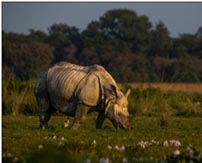
The Indian rhinoceros (Rhinoceros unicornis), or Indian rhino for short, also known as the greater one-horned rhinoceros or great Indian rhinoceros, is a rhinoceros species native to the Indian subcontinent. It is listed as Vulnerable on the IUCN Red List, as populations are fragmented and restricted to less than 20,000 km2 (7,700 sq mi). Moreover, the extent and quality of the rhino's most important habitat, the alluvial Terai-Duar savanna and grasslands and riverine forest, is considered to be in decline due to human and livestock encroachment. As of August 2018, the global population was estimated to comprise 3,588 individuals, including 2,939 individuals in India and 649 in Nepal. Kaziranga National Park alone had an estimated population of 2,048 rhinos in 2009. Pobitora Wildlife Sanctuary in Assam has the highest density of Indian rhinos in the world with 84 individuals in an area of 38.80 km2 (14.98 sq mi) in 2009.